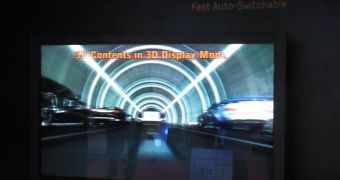The problem with 3D technologies is that they haven't really come to a point where they can do without 3D glasses, and it seems that even one of the more promising prototypes on Samsung's side of the field isn't going to become a selling product in the near future.
Until late 2009, the 3D display mode was restricted to certain cinemas and just a handful of monitors and TV sets.
After 3D films started to show up more often, however, a real effort appeared for the encouragement of 120 Hz (or faster) panels, plus media in this format (movies, TV broadcasts, channels etc.).
To some extent, one might say the attempt was a success, as sales of this type of panels more or less soared during 2010.
Unfortunately, this is just in comparison to what shipment levels there were in previous years, as 3D panels still account for just a small percentage of the total LCD sales.
The main reason for this is that there is still a reliance on 3D glasses, even though some prototypes did experiment with technologies that tried to remove this need.
Unfortunately, the industry is still far from achieving this purpose, as made abundantly clear by how CEA saw fit to start work on an active 3D glasses standard.
In the meantime, Samsung has been developing a 3D LCD TV prototype that hopes to eventually so away with all sort of necessary eyewear, or so it is reported.
It has a screen size of 55 inches and an optimal viewing distance of 2.5 to 6 meters, while the number of veiwpoints is nine.
The means chosen by the company was the use of not one, but two LCD (liquid crystal display) panels on top of one another.
The first LCD panel is the one that actually displays the images, while the other panel is set in front of it and, unlike the previous one, has a changeable refraction index.
In other words, the second panel can act as a lens and show the two sets of images for the right and left eyes (2D images are displayed by not changing said index).
The model showcased used CCFL backlights and has a contrast ratio of 4,000:1, plus Full HD support (1,920 x 1,080 pixels) at 500 cd/m2 brightness. It will take about three years to turn it into a marketing-viable product, by which time CCFL should be exchanged for LED.

 14 DAY TRIAL //
14 DAY TRIAL //